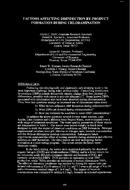Provide PDF Format
AWWA ACE95271
- Factors Affecting Disinfection By-Product Formation During Chloramination
- Conference Proceeding by American Water Works Association, 01/01/1995
- Publisher: AWWA
$12.00$24.00
Controlling disinfection byproducts (DBPs) sounds deceptively simple, change from free chlorine to chloramines, possibly with ozone to provide adequate CT. Some known DBPs associated with chlorination also have been observed during chloramination. Thus, three key questions emerge as increased use of chloramines takes place: What factors influence DBP formation during chloramination? What DBPs are formed during chloramination? How can treatment be modified to lower DBP concentrations? To address the above questions several diverse water sources, Lake Austin, Lake Houston, and California State Project Water, were evaluated over a wide range of treatment conditions. The waters were tested initially in batch tests designed to study the impact of chemical conditions on DBP formation. Principal experimental variables were pH, chlorine to nitrogen ratio, bromide concentration and the 48-hour chloramine residual concentration. Subsequent batch experiments examined the effect of mixing intensity during ammonia and chlorine addition on DBP formation. The three waters are now undergoing further evaluation in a pilot testing program. This report covers the batch water chemistry results. In the batch testing, the waters were monitored primarily for dissolved organic halogen (DOX) and trihalomethanes (THMs), and to a lesser extent for six haloacetic acids (HAA6), cyanogen chloride and bromide (CNX), and currently unidentified DBPs. DOX provides an indication of total DBP production, while THMs provide an indication of typical chlorination DBPs. The effect of chemistry conditions was studied by dosing the waters with preformed chloramines at Cl2:N ratios of 3:1, 5:1 and 7:1 over a pH range of 6 to 10 and a chloramine residual range of 1 to 4 mg/L. The impact of bromide concentration was evaluated by adding 0.5 mg/L bromide in selected experiments.
Related Products
AWWA WQTC50488
A Comparison of Particle Removal Efficiency in Biological and Conventional Filters..
$12.00 $24.00
AWWA JAW63370
Journal AWWA - Third-Party Billing of Multifamily Customers Presents New Challenges to Water Provide..
$15.00 $30.00
AWWA MTC57556
Implications and Issues with Reverse Osmosis Treatment of Air Stripped Groundwater: City of Scottsda..
$12.00 $24.00





